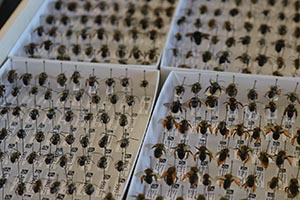Notes from the Lab
The Importance of Habitat to Both Native and Managed Bees

Location, location, location. Any real estate agent will tell you it’s critical. But does the same rule apply to bees? In other words, if you could construct the optimal real estate for bees, what would it look like? Lots of wooded areas? Flowering crops? And what bees are we talking about, exactly? The western honey bee (Apis mellifera) forages at a larger radius, collects more nectar, and is active for a longer portion of the year than the other ~4,000 species of bees in North America. Does that mean its ideal habitat is different from other bees? This is the topic for our fifteenth “Notes from the Lab,” where we highlight “Wild, native bees and managed honey bees benefit from similar agricultural land uses,” written by Elaine Evans and colleagues and published in the journal Agriculture, Ecosystems and Environment [268:162-170 (2018)].
In case you didn’t know, North Dakota is essentially Mecca for bees. It’s the top honey producing state in the U.S., with nearly a half million colonies producing over 17 million kilograms of honey/year, valued at ~$70 million annually. In addition, North Dakota is home to >300 species of wild bees. However, for the past 10 years, there’s been a dramatic increase in land used for corn and soy production in the state. This has led to concern about loss of bee forage and potential impact on pollinators and honey production.
To address these concerns, Evans and colleagues set out to understand what was good habitat for bees in North Dakota. The authors sampled, counted and identified 13,426(!) wild bees, representing 149 species from 18 locations over the course of 3 years. They also monitored honey bee colonies from 6 apiaries, measuring honey production and proportion of colonies surviving each year. Finally, they used data gathered by the U.S. Geological Survey — essentially a handmade version of Google Maps — to determine the exact composition of different types of land-use (i.e., different habitat for bees) around each of the sample locations. Then, once they had all of these data in hand, they looked to see if there were relationships between land-use, wild bee abundance/diversity, and honey bee productivity/survival.
So, what did they find? Was good habitat for honey bees the same as good habitat for wild, native bees? To a large degree, yes. The authors found that wild bee abundance and diversity were positively associated with honey production by honey bees. In other words, if an apiary was good at producing honey, it also had a more abundant and diverse wild bee community nearby. This supports the notion that good habitat for honey bees is also good habitat for wild, native bees.
What made some locations better than others? This is what we all want to know, of course. If you could pick anywhere on a map to put your bees, what should you be looking for? Or, if you wanted to conserve and promote wild, native bees, which ….


